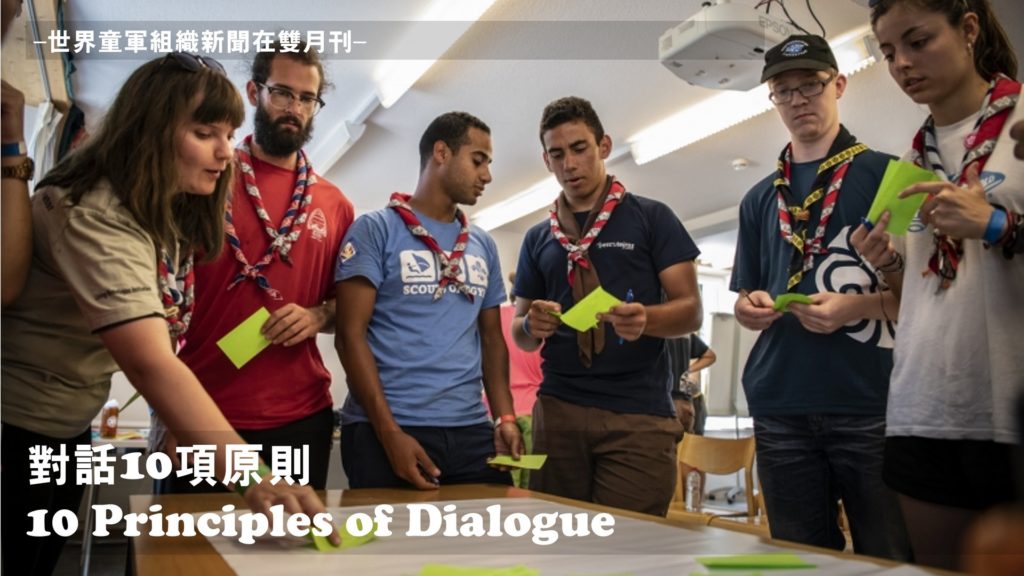原文/圖 : WORLD Organization of the Scout Movement (WOSM)
Creator: World Scout Bureau Global Support Centre, Kuala Lumpur
轉載編譯/ 雙月刊編輯團隊
(如有編譯不周還望各界專業前輩不吝撥空賜教)
摘要
一場好的對話,不僅能達到應有的溝通程度及關鍵訊息的傳達,它是簡短有力且能發人省思,世界童軍運動組織(World Organization of the Scout Movement, WOSM)為此,撰寫了一篇實用的精簡的如何介紹對話的原則在此轉載譯成中文分享給關心教育的各界人士。
內文
作為童子軍領袖,我們可以通過為年輕人創造一個安全的空間來支持他們,讓他們分享他們的擔憂和想法,進行有意義的對話和富有成效的對話。As Scout Leaders, we can support young people by creating a safe space for them to share their concerns and ideas, have meaningful conversations and productive dialogue.
您可以通過引導性問題和小型活動以有趣的方式向年輕人介紹對話的10項原則 You can introduce the 10 principles of dialogue to young people in a fun way with guiding questions and small activities.
使用此列表幫助指導您,並查閱《和平促使者對話手冊》以瞭解更多資訊。Use this list to help guide you, and consult the Dialogue for Peace Facilitator’s Handbook to learn more.

從下面的問題中獲得靈感,知道您不需要一次涵蓋所有這些問題 – 您可以一次選擇3-4個:Get inspired by the questions below, knowing that you don’t need to cover all of these questions at once – you can pick and choose 3-4 at a time:
對話10項原則
1、為了説明建立一個安全的空間,問問:
我們如何才能使這個空間安全舒適地進行討論?讓參與者提出想法並按照他們的建議組織空間。
To help establish a safe space, ask:
How can we make this space safe and comfortable to have discussions?
Let participants propose ideas and organise the space as they suggest.
2、 要理解對話是關於學習的,問問:
在這個對話結束時,我們想學到什麼 ? 讓參與者分享他們想學習的東西。
To understand that dialogue is about learning, ask:
What do we want to learn by the end of this dialogue circle?
Let participants share what they want to learn.
3、為了鼓勵使用適當的溝通技巧,問問:
你希望人們如何與你交談?
To encourage the use of appropriate communication skills, ask:
How do you want people to talk to you?
4、要制定適當的基本規則,請問:
在繼續對話之前,我們應該制定哪些規則?
To set proper ground rules, ask:
What rules should we set before continuing this conversation?
5、為了鼓勵年輕人表達自己的感受,誠實地面對感知,問問:
你能不能分享一下你的想法,從“我覺得……”開始。或“我認為…”?
To encourage young people to surface their feelings and confront perceptions with honesty, ask:
Can you share what is on your mind, starting with “I feel…” or “I think…”?
6、提醒年輕人優先考慮人際關係,問問:
在這個群體中誰是朋友或親戚?你最喜歡和他們聯繫的什麼?
To remind young people to prioritise relationships, ask:
Who is a friend or relative in this group? What do you like most about your connection with them?
7、要逐步解決難題,請問:
哪些話題對你來說是難以啟齒的?
To gradually address difficult questions, ask:
What topics are difficult for you to talk about?
8、為了停止對話或避免難以啟齒的問題,問問:
為什麼這些話題對你來說很難談論?
To prevent quitting or avoiding difficult issues, ask:
Why are these topics difficult for you to talk about?
9、為了樹立對話可以用新的觀點和想法改變我們的期望,問問:
從現在開始,你想做些什麼不同的事情來促進友誼?
To set the expectation that dialogue can transform us with new perspectives and ideas, ask:
What is something you want to do differently from now on to promote friendship?
10、為了鼓勵年輕人分享他們所學到的東西,問問:
你今天學到了一些你想與他人分享的新東西嗎?
To encourage young people to share what they learn, ask:
Did you learn something new today that you want to share with others?
請記住,在討論之前始終要制定基本規則,以確保每個人都可以自由和友善地發言,一次一個。如果出現你不知道答案的問題,最好誠實地說你不知道。讓他們知道他們可以問誰,或者你下次會給他們一個答案。

對話十項原則(簡要複習)
1、建立安全空間
2、同意對話的主要目的是學習
3、使用適當的溝通技巧
4、制定適當的基本規則
5、承擔風險、表露情感並誠實地面對看法
6、關係是第一位的
7、逐漸解決難題並逐漸離開它們
8、不要放棄或避免困難的問題
9、期待改變:一旦參與對話,期待改變
10、將改變帶給他人
SafeScouts
與雙月刊進一步的多元連結




